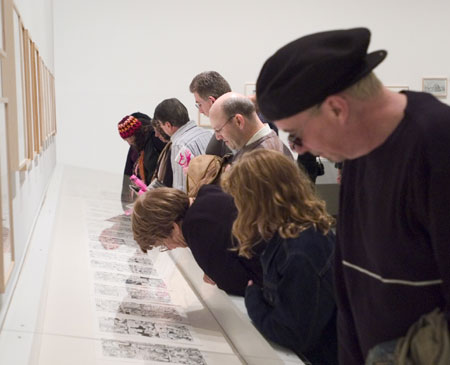Back

The 2004-5 Carnegie International drew thousands
of visitors from the region and around the world to Pittsburgh.
Photo: Tom Altany
"I wasn’t sure what the artists would give
me, but I think it paid off,” says Laura Hoptman,
curator of the 2004-5 Carnegie International.
In retrospect, Hoptman
says she took a lot of risks with the show by commissioning
more new works than usual “to keep the platform fresh.”
Most
of the works were installed by the artists, which required
careful collaboration between the artists and
Carnegie Museum of Art’s staff. “The greatest
challenge was to integrate the artists’ visions with
the needs of the museum,” says Hoptman. What made
the process exciting for her was that “the artists
believed in the show, shared ideas, and created a community
of opinion.”
Paul Krainak, a painter and art professor
at West Virginia University, has seen many of the Carnegie
Internationals,
and visited the 2005 show 10 times. “What was most
successful about this show was that there were a lot of
artists represented who were important to me,” says
Krainak. “For example, Julia Mehretu was the highlight
for me. I thought her works were brilliant.”
Another
local artist, Fran Gialamas, has been attending Carnegie
Internationals since she was an art student in
1955. “As a student, I saw my first original artworks
while touring the Carnegie International. I saw my first
Picassos, my first Andrew Wyeths, and the Calder mobile,” she
says.
She was taken with Mehretu’s large-scale paintings
as well, calling them “fantastic
work.” Gialamas says, “People should appreciate the Carnegie
Internationalfor the opportunity to see the actual works—in scale—in that gorgeous
space,” instead of seeing them reproduced in books and journals.
While Hoptman
searched for artists to be represented in the Carnegie International, she also
hunted for works that could be added to the museum’s permanent
collection. “In general, this is the most comprehensive and aggressive
purchase plan since 1950,” says Richard Armstrong, The Henry J. Heinz
II Director of Carnegie Museum of Art. “Laura was a very shrewd shopper
and took us to artists when we could still afford them two-and-a-half years
ago.
The pieces we bought are not necessarily the ones in the show, but they are
important works by the same artists.”
Although reviews by critics were
mixed, both Hoptman and Armstrong say the show was a success. “In Pittsburgh,
the reception was fantastic,” says
Hoptman. As for the critics, Hoptman says the reviews were half good and
half bad, with some critics on the coasts “ticked” that they
didn’t
know the artists. “But they didn’t bother to do any research,” she
adds.
Armstrong says the reception “was a direct response
to the complexity of the exhibition.” The show required
repeat visits—and attention
to the nuances and details—to understand the works. “I liked
the show at the beginning, and grew increasingly fond of it as I visited
it repeatedly,” he
says.
In contrasting the 2004-5 show with the 1999-2000 Carnegie
International, Armstrong says this exhibition was introverted,
while the previous show
was extroverted
and playful. In his opinion, both exhibitions accurately reflected their
times and captured the vision and temperament of the curators. “The
exhibition took a critical view of culture now—both established
and emerging artists wanted to participate,” says Hoptman. Armstrong
adds, “I can predict
that the artists of this show will become the important figures of their
generations.”
Says Krainak, “Although politics and philosophy
were guiding forces in Hoptman’s selections, the resulting show
was far more intimate, despite its large scale and big narratives.” He
adds, “To its credit, the
International did not try to compete with other popular venues for
audience. It directed its attention toward art lovers rather than thrill
seekers.”
One of the most beneficial outcomes ofthis year’s
exhibition was the creation of the “Friends of the
Carnegie International,” a group of contemporary
art aficionados and collectors from around the world co-chaired
by Milton and Sheila Fine and Jill and Peter Kraus, to
help fund the Carnegie International through
private
donations.
“
I hope this show and its reception has proved that the Carnegie
International is an enormously important jewel—for
both the American and international cultural scenes,” says
Hoptman. “The fact that Pittsburghers are
willing to host a show like this is a great example of the stuff
that Pittsburghers are made of.”
Carnegie Museum of Art Purchased 27 Works
by Carnegie
International Artists
For more than a century, the Carnegie International has
served Pittsburgh well as a means to establish an outstanding
collection of modern art. That tradition continues with
the acquisition of 27 works by artists included in the
2004-5 Carnegie International.
Acquisitions of work in the 2004-5
Carnegie International:
Kutlug Ataman, Kuba, 2004
Kathy Butterly, Lickety, 2002
Kathy Butterly, Trip, 2002
Paul Chan, Happiness (Finally) After 35,000 Years of
Civilization—After
Henry Darger and Charles Fourier, 2000-2003
Anne Chu, Nine Hellish Spirits No. 2, 2004
Robert Crumb, Fanny and Joe, 2003
Robert Crumb, Untitled (Carnegie International poster),
2004
Peter Doig, Driftwood, 2001-2002
Isa Genzken, Empire/Vampire III, #1, 2004
Mangelos, Manifesto on the machine no. 2, 1977-78
Julie Mehretu, Untitled (Stadia III), 2004
Senga Nengudi, R.S.V.P. XI, 1977/2004
Acquisitions of work by artists included in the
2004-5
Carnegie International:
Tomma Abts, Teete, 2003
Pawel Althamer, Self-Portrait As an Old Man, 2003
John Bock, Farmslave in Massecuschitz (small stage), 1999
Peter Doig, Study for Driftwood, 2003
Trisha Donnelly, Sea Battles, 2003
Saul Fletcher, Untitled #10 (Bathroom Cabinet), 1997
Saul Fletcher, Untitled #23 (Flower Pots), 1997
Mark Grotjahn, Untitled (Red Butterfly Over Green), 2003
Rachel Harrison, Utopia, 2002
Carsten Höller, Mushroom Prints, 2004
Jim Lambie, Boy Hairdresser, 2001
Neo Rauch, Art, 2002
Neo Rauch, Rückkehr, 2004
Ugo Rondinone, No. 249 EINUNDZWANZIGSTERSEPTEMBERZWEIT–AUSENDUNDEINS,
2001
Eva Rothschild, Lighter Later, 2003
Back
| Top
|